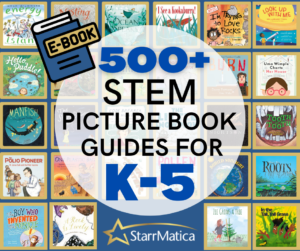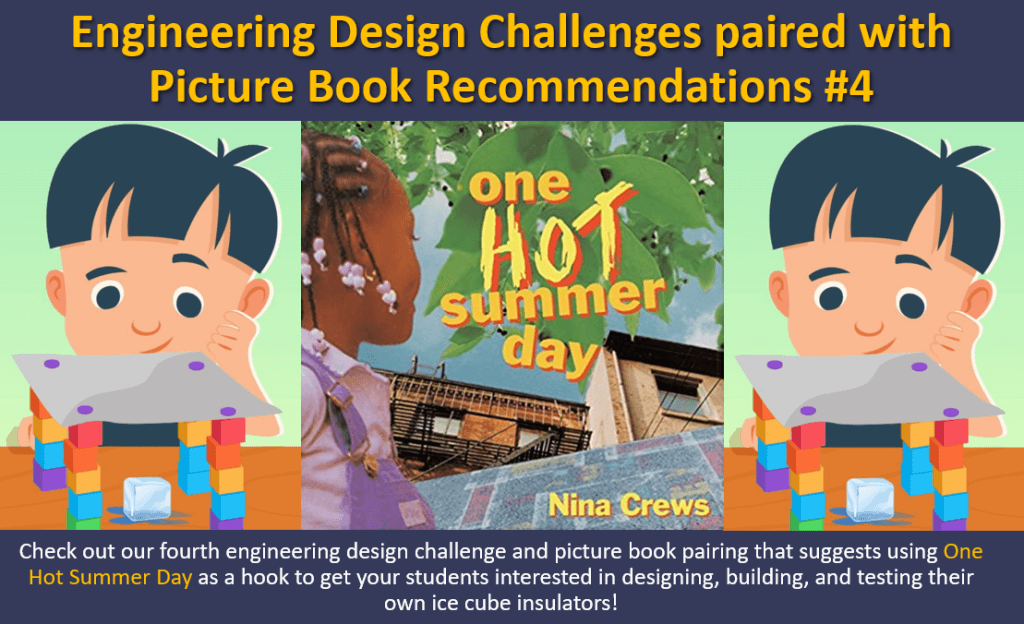Welcome to our fourth engineering challenge post to help you keep your students engaged the last few weeks of school. (You can find the first three challenges here, here, and here.)
You’ll see in this post, as in previous posts, that my intention is not to provide an entire NGSS-aligned lesson plan. My goal is to share resources you can use to design a lesson that meets your specific classroom needs.
Our fourth challenge is The Ice Cube Insulator Challenge paired with One Hot Summer Day by Nina Crews.
This challenge is a common one you have probably seen (or even tried) before. It is a tremendous engineering challenge that explicitly addresses:
- K-PS3-2 Use tools and materials to design and build a structure that will reduce the warming effect of sunlight on an area. So, it is often used as the “go-to” challenge for that performance expectation. Yet, because it also addresses the engineering performance expectations shown below, the challenge can be adapted for any grade level.
- K-2-ETS1-2 Develop a simple sketch, drawing, or physical model to illustrate how the shape of an object helps it function as needed to solve a given problem.
- 3-5-ETS1-3 Plan and carry out fair tests in which variables are controlled, and failure points are considered to identify aspects of a model or prototype that can be improved.
You could begin your lesson by reading aloud One Hot Summer Day by Nina Crews. This picture book with photograph illustrations tells the story of one young girl’s hot summer day. The book provides a hook to get students thinking about hot weather and ways to stay cool.
Reading Activities:
As you are reading the text, you could have your students keep track of the strategies people use to stay cool. Then after reading, you could have students add their own ideas and strategies to the list.
The Challenge:
The book provides a nice lead to the challenge of designing a solution to keep an ice cube cool. If you aren’t familiar with this challenge, students are asked to engineer a structure that will keep an ice cube from melting for the longest time.
Constraint Considerations:
You’ll want to consider your time constraints when designing your lesson. Testing your ice cubes will obviously proceed more quickly outside on a hot summer day, but don’t feel that you have to wait for nice weather to enjoy this engineering challenge. – Any ice cube outside of a freezer will melt eventually!
Materials are always a constraint to consider. For this challenge in particular, the more materials you can provide your students with, the better. Narrowing their materials narrows their design options and increases the chances their solutions will all look similar.
Shady Discussion
When doing this challenge with my sons, I did not discuss the role shade plays in keeping things cool. The picture book mentions shade, and certainly, my boys have had experience keeping cool in the summer by staying in the shade. But by explicitly discussing shade, I felt I would be pointing them in a design direction that I would rather have them discover independently. Like I shared with the bridge challenge in the last post, the less direct information you provide upfront, the better. We want students to be engaging in the activity as engineers who are tasked with figuring out a solution.
Other Considerations:
Decide ahead of time how you will keep track of how long the ice cube takes to melt. Does each team have a stopwatch? Is there one master stopwatch, and teams call out when their ice cube has melted and their time is recorded? You may even need to discuss what it will look like when their ice cube is fully melted. Be sure to have a control ice cube that is not protected by any insulation.
Post Test Activities:
Once you have run your first test, have the students compare their results to the control cube and each other. You may want to create a class graph (or individual graphs) of the data to help with comparing. Ask your students to discuss which designs worked the best and to provide evidence for their claims. You could allow students to hypothesize why they believe some designs worked better than others and then have the opportunity to design an investigation to test their theories. This might include revising their designs, creating new designs, and/or collaborating between groups. Some students may also want to do some independent research at this point about how different materials and colors reflect and absorb heat. And some students may come up with new questions to investigate. For example, “Is shade a larger factor in keeping an ice cube cool outside than it is inside?”
By continuing the discussion and engineering beyond the first test, you encourage your students to do what “real” engineers do. Testing and making modifications is an integral part of real-world problem solving, and we want to be sure we don’t deprive our students of that experience in our classrooms. The more we can show students early in their careers that failure and revision are a part of the learning process, the more they expect and embrace it in the future.
If you are a StarrMatica Texts: Science Your Way subscriber, you can check out the engineering and energy informational texts below. Remember, each 1st – 5th grade text has multiple reading levels, so all of your students can read the same content independently. I recommend having students read the kindergarten texts after they have built their structures. Used this way, the texts help students learn vocabulary and background information they can use to explain what they have learned on their own. You could use the 3rd-5th grade engineering texts either before or after your designs. If you choose to use them before, students could model their tests after the engineering steps discussed in the text. If you decide to use them after, students could compare their tests to those in the texts.
- Kindergarten: Stay in the Shade and Keeping Cool
- 3rd-5th Engineering: Watering Your Garden on Vacation
- 3rd-5th Engineering: Two Ways to Solve a Problem
- 3rd-5th Engineering: Testing Prototypes
Not a subscriber? Click here for a free trial to access the texts above.
Structure and function and cause and effect are the main crosscutting concepts that fit well with this challenge.
And students are using nearly all of the science and engineering practices. They are developing and using models as they construct their designs. Students are planning and carrying out investigations to test how long it takes for the ice cube to melt. They are constructing explanations and designing solutions when determining why some designs worked better than others. When they share their designs with peers and discuss the trial results, they obtain, evaluate, and communicate information. When creating graphs and reviewing the trial results, they analyze and interpret data and use mathematics and computational thinking.
As a fun extension, you could bring in different products designed by real-life engineers to keep ice from melting. Run your own tests to see which coolers, thermoses, and tumblers you would recommend to consumers!
 Are you are looking for additional picture books for your science classroom, check out the Perfect Picture Book Pairing Series that includes one-page guides with activities and discussion questions for hundreds of STEM-themed picture books aligned to every NGSS performance expectation!
Are you are looking for additional picture books for your science classroom, check out the Perfect Picture Book Pairing Series that includes one-page guides with activities and discussion questions for hundreds of STEM-themed picture books aligned to every NGSS performance expectation!
CLICK HERE TO PREVIEW THE PERFECT PICTURE BOOK PAIRING EBOOKS

